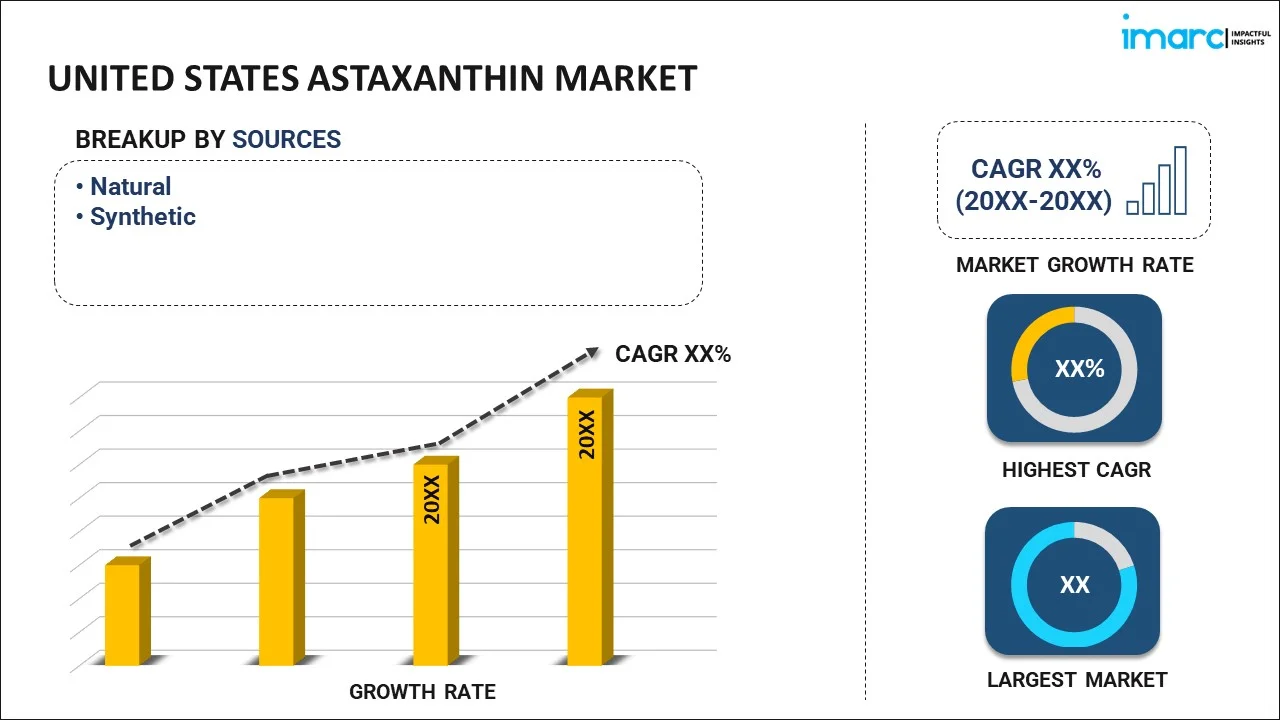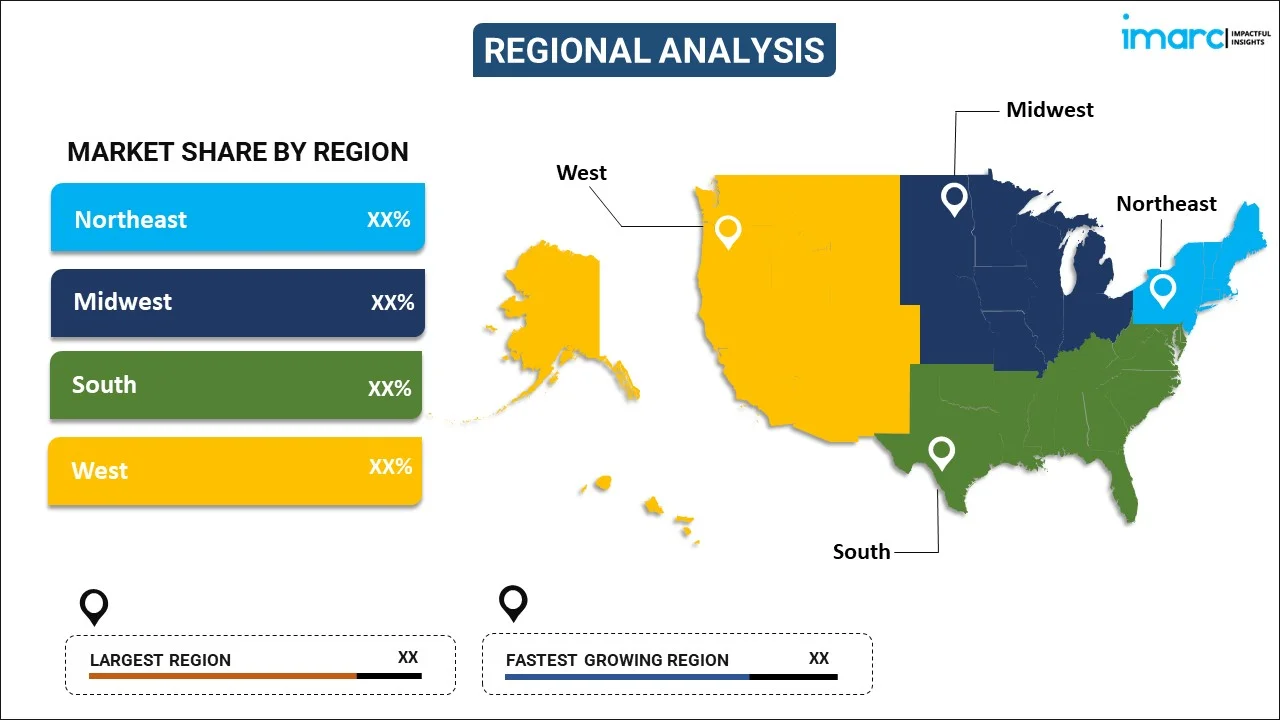
United States Astaxanthin Market Report by Source (Natural, Synthetic), Product (Dried Algae Meal or Biomass, Oil, Softgel, Liquid, and Others), Application (Nutraceuticals, Cosmetics, Aquaculture and Animal Feed, and Others), and Region 2024-2032
Market Overview:
The United States astaxanthin market size reached US$ 267.6 Million in 2023. Looking forward, IMARC Group expects the market to reach US$ 500.2 Million by 2032, exhibiting a growth rate (CAGR) of 7.20% during 2024-2032. The increasing recognition of the compound's health benefits and its diverse applications, the rising demand for astaxanthin in nutraceuticals and dietary supplements, the expanding applications in the aquaculture industry, and the growing cosmetics and personal care industry are some of the factors propelling the market.
|
Report Attribute
|
Key Statistics
|
|---|---|
|
Base Year
|
2023 |
|
Forecast Years
|
2024-2032 |
|
Historical Years
|
2018-2023
|
| Market Size in 2023 | US$ 267.6 Million |
| Market Forecast in 2032 | US$ 500.2 Million |
| Market Growth Rate (2024-2032) | 7.20% |
Astaxanthin is a naturally occurring carotenoid pigment that belongs to the xanthophyll family, renowned for its vibrant red-orange color. It is found in certain microalgae, fungi, and aquatic organisms. It is a powerful antioxidant known for its exceptional health benefits. The compound is notably abundant in microalgae Haematococcus pluvialis, which serves as a primary source for commercial astaxanthin production. In nature, astaxanthin plays a crucial role in the defense mechanisms of certain marine species, acting as a shield against the harmful effects of ultraviolet (UV) radiation and oxidative stress. It has a unique molecular structure, allowing it to span the entire cell membrane and protect both the water-soluble and fat-soluble parts of cells. This dual capability makes astaxanthin an extraordinarily effective scavenger of free radicals, which are implicated in various degenerative diseases and aging processes. Beyond its role as a potent antioxidant, astaxanthin has gained prominence for its anti-inflammatory properties and its ability to support joint, skin, and eye health. Its versatility extends to applications in nutraceuticals, dietary supplements, animal feed, cosmetics, and functional foods, where it is harnessed for its multifaceted benefits.
United States Astaxanthin Market Trends:
The market in the United States is majorly driven by the increasing awareness of its health benefits and its versatile applications across various industries. In line with this, the rising demand for natural antioxidants and health supplements is positively influencing the market. As consumers in the U.S. place a premium on wellness and preventive healthcare, the antioxidant properties of astaxanthin have garnered attention. This is leading to a growth in the incorporation of astaxanthin in nutraceuticals and dietary supplements, thereby fueling the market. Furthermore, the prominence of astaxanthin in the aquaculture industry, particularly in fish and shrimp feed to enhance coloration and promote growth is resulting in a higher product uptake. Besides, the cosmetics and personal care industry has also played a role in catalyzing the market. The product's antioxidant and anti-aging properties have positioned it as a sought-after ingredient in skincare formulations. As the U.S. cosmetic industry witnesses a trend toward clean and natural ingredients, astaxanthin's potential to protect the skin from oxidative stress and UV damage has led to its incorporation in a variety of skincare products. Moreover, the application of astaxanthin in functional foods and beverages is propelling the market growth. The food and beverage industry, in response to consumer demands for healthier choices, has embraced the inclusion of functional ingredients. Additionally, the rapid technological advancements in astaxanthin production processes have further fueled market growth. Improved cultivation techniques, extraction methods, and biotechnological innovations have enhanced the efficiency of astaxanthin production, making it more commercially viable and scalable. This, in turn, is contributing to a more cost-effective supply of astaxanthin, meeting the growing product demand across diverse industries.
United States Astaxanthin Market Segmentation:
IMARC Group provides an analysis of the key trends in each segment of the market, along with forecasts at the country level for 2024-2032. Our report has categorized the market based on source, product, and application.
Source Insights:

- Natural
- Yeast
- Krill/Shrimp
- Microalgae
- Others
- Synthetic
The report has provided a detailed breakup and analysis of the market based on the source. This includes natural (yeast, krill/shrimp, microalgae, and others) and synthetic.
Product Insights:
- Dried Algae Meal or Biomass
- Oil
- Softgel
- Liquid
- Others
A detailed breakup and analysis of the market based on the product have also been provided in the report. This includes dried algae meal or biomass, oil, softgel, liquid, and others.
Application Insights:
- Nutraceuticals
- Cosmetics
- Aquaculture and Animal Feed
- Others
The report has provided a detailed breakup and analysis of the market based on the application. This includes nutraceuticals, cosmetics, aquaculture and animal feed, and others.
Regional Insights:

- Northeast
- Midwest
- South
- West
The report has also provided a comprehensive analysis of all the major regional markets, which include the Northeast, Midwest, South, and West.
Competitive Landscape:
The market research report has also provided a comprehensive analysis of the competitive landscape in the market. Competitive analysis such as market structure, key player positioning, top winning strategies, competitive dashboard, and company evaluation quadrant has been covered in the report. Also, detailed profiles of all major companies have been provided.
United States Astaxanthin Market Report Coverage:
| Report Features | Details |
|---|---|
| Base Year of the Analysis | 2023 |
| Historical Period | 2018-2023 |
| Forecast Period | 2024-2032 |
| Units | US$ Million |
| Scope of the Report | Exploration of Historical Trends and Market Outlook, Industry Catalysts and Challenges, Segment-Wise Historical and Future Market Assessment:
|
| Sources Covered |
|
| Products Covered | Dried Algae Meal or Biomass, Oil, Softgel, Liquid, Others |
| Applications Covered | Nutraceuticals, Cosmetics, Aquaculture and Animal Feed, Others |
| Regions Covered | Northeast, Midwest, South, West |
| Customization Scope | 10% Free Customization |
| Report Price and Purchase Option | Single User License: US$ 3699 Five User License: US$ 4699 Corporate License: US$ 5699 |
| Post-Sale Analyst Support | 10-12 Weeks |
| Delivery Format | PDF and Excel through Email (We can also provide the editable version of the report in PPT/Word format on special request) |
Key Questions Answered in This Report:
- How has the United States astaxanthin market performed so far and how will it perform in the coming years?
- What has been the impact of COVID-19 on the United States astaxanthin market?
- What is the breakup of the United States astaxanthin market on the basis of source?
- What is the breakup of the United States astaxanthin market on the basis of product?
- What is the breakup of the United States astaxanthin market on the basis of application?
- What are the various stages in the value chain of the United States astaxanthin market?
- What are the key driving factors and challenges in the United States astaxanthin testing?
- What is the structure of the United States astaxanthin market and who are the key players?
- What is the degree of competition in the United States astaxanthin market?
Key Benefits for Stakeholders:
- IMARC’s industry report offers a comprehensive quantitative analysis of various market segments, historical and current market trends, market forecasts, and dynamics of the United States astaxanthin market from 2018-2032.
- The research report provides the latest information on the market drivers, challenges, and opportunities in the United States astaxanthin market.
- Porter's five forces analysis assist stakeholders in assessing the impact of new entrants, competitive rivalry, supplier power, buyer power, and the threat of substitution. It helps stakeholders to analyze the level of competition within the United States astaxanthin industry and its attractiveness.
- A competitive landscape allows stakeholders to understand their competitive environment and provides an insight into the current positions of key players in the market.
Need more help?
- Speak to our experienced analysts for insights on the current market scenarios.
- Include additional segments and countries to customize the report as per your requirement.
- Gain an unparalleled competitive advantage in your domain by understanding how to utilize the report and positively impacting your operations and revenue.
- For further assistance, please connect with our analysts.
 Inquire Before Buying
Inquire Before Buying
 Speak to an Analyst
Speak to an Analyst
 Request Brochure
Request Brochure
 Request Customization
Request Customization




.webp)




.webp)












